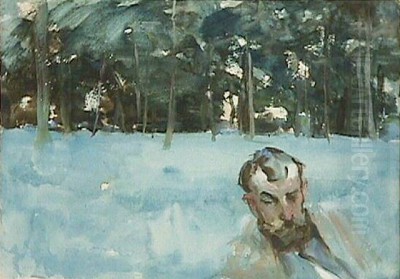
George Hitchcock (1850-1913) stands as a significant, if sometimes overlooked, figure in the wave of American artists who sought inspiration and training in Europe during the late nineteenth and early twentieth centuries. Born in Providence, Rhode Island, Hitchcock carved a unique niche for himself, becoming renowned for his luminous depictions of Dutch landscapes, particularly the vibrant tulip fields and the serene peasant life of Holland. Though an American by birth, his artistic heart found its home in the Netherlands, where he spent the most productive years of his career, contributing to the rich tapestry of expatriate art and influencing a generation of painters.
Early Life and Artistic Awakening
George Hitchcock was born on September 29, 1850, into a New England family that initially guided him towards a more conventional career path. He pursued academic excellence, graduating from Brown University and later from Harvard Law School in 1874. For a brief period, he practiced law in Providence and New York City. However, the allure of art proved stronger than the demands of jurisprudence. A visit to the 1876 Centennial Exposition in Philadelphia, with its vast display of international art, is often cited as a pivotal moment, igniting his passion and steering him towards a creative life.
By 1879, Hitchcock had made the decisive leap to abandon law and dedicate himself to painting. Like many aspiring American artists of his time, he recognized that Europe offered unparalleled opportunities for artistic training and exposure. He initially traveled to London, where he is believed to have studied watercolor painting. However, Paris, the undisputed art capital of the world, soon beckoned.
Parisian Training and Formative Influences
In Paris, Hitchcock enrolled at the prestigious Académie Julian, a popular choice for foreign students, including many Americans. There, he studied under Gustave Boulanger and Jules Lefebvre, both respected academic painters. This training provided him with a strong foundation in drawing and composition, adhering to the classical traditions still dominant in the French Salons. He also spent time studying at the École des Beaux-Arts.
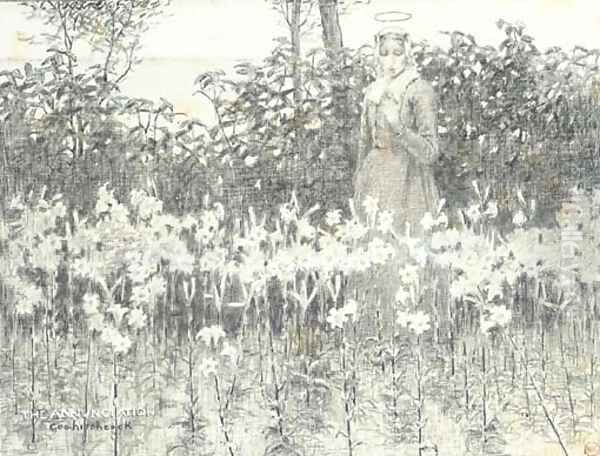
During his time in Paris, Hitchcock would have been exposed to the burgeoning Impressionist movement, which was radically challenging academic conventions. Artists like Claude Monet, Camille Pissarro, and Edgar Degas were revolutionizing the way light, color, and contemporary life were depicted. While Hitchcock's early work retained academic qualities, the Impressionists' emphasis on plein air painting and the optical effects of light would profoundly shape his later development. He also studied in Düsseldorf, Germany, another important art center, though Paris remained the primary hub of his early artistic education. His works began to appear in the Paris Salon, an important venue for gaining recognition.
The Call of Holland: Egmond aan Zee
After his formative years in Paris and elsewhere in Europe, Hitchcock sought a location that could offer fresh inspiration and a distinct artistic identity. Around 1883 or 1884, he discovered the Netherlands. He was captivated by the unique quality of Dutch light, the picturesque landscapes, the charming rural villages, and the traditional way of life that seemed to persist, untouched by rapid industrialization. He initially settled in Egmond aan den Hoef, a small village near Egmond aan Zee on the North Sea coast.
This move proved to be a turning point in his career. The Dutch environment provided him with the subjects that would define his oeuvre: expansive fields of tulips, hyacinths, and other flowers; serene canals reflecting the vast skies; and local peasants, often women and children, in their distinctive traditional costumes. He was particularly drawn to the interplay of bright sunlight on these scenes, earning him the moniker "the painter of sunlight."
The Egmond School and Artistic Community
In Egmond, Hitchcock was not an isolated figure. He became a central personality in what became known as the Egmond School, an informal art colony that attracted artists from various countries. A key associate and friend was Gari Melchers, another prominent American expatriate artist who also settled in Egmond around the same time. Together, Hitchcock and Melchers were instrumental in fostering a vibrant artistic community. Their presence helped to draw other painters to the area, creating a supportive and stimulating environment for creative work.
The Egmond artists, while diverse in their individual styles, shared an interest in depicting the local scenery and peasant life. They often worked outdoors, embracing the principles of plein air painting to capture the immediate effects of light and atmosphere. Hitchcock's home and studio became a gathering place, and he also ran a summer art school, further cementing Egmond's reputation as an artistic destination. His influence extended to many students and visiting artists who sought his guidance.
Artistic Style: Light, Color, and Dutch Motifs
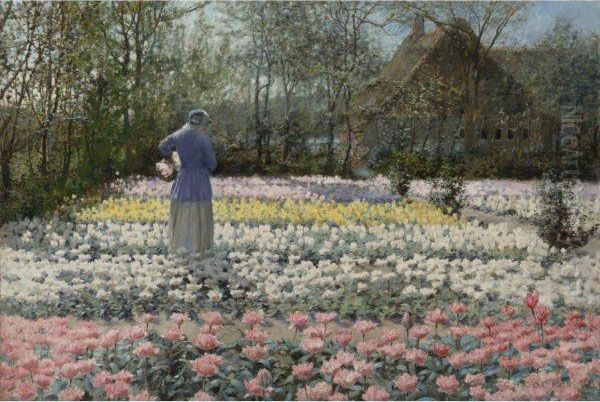
George Hitchcock's mature style is characterized by its bright palette, its emphasis on sunlight, and its romanticized yet observant portrayal of Dutch rural life. He masterfully captured the brilliant hues of the Dutch flower fields, particularly the iconic tulips, rendering them with a vibrancy that was both decorative and evocative. His paintings often feature strong contrasts between light and shadow, with figures illuminated by a clear, almost ethereal light.
While influenced by French Impressionism in his approach to light and color, Hitchcock's work often retained a greater degree of definition and narrative clarity than that of many of his French counterparts like Monet or Pissarro. His figures, though part of the landscape, are usually well-defined and play a central role in the composition. There's a certain idyllic quality to his scenes, a sense of timelessness and tranquility that appealed to contemporary audiences.
His subjects frequently included young women and children in traditional Dutch attire, engaged in activities such as flower gathering, tending gardens, or simply pausing in a sun-drenched field. These figures are often imbued with a sense of innocence and grace. Hitchcock also explored religious themes, but he uniquely reinterpreted them within a contemporary Dutch setting, a stylistic choice that garnered considerable attention.
Signature Works: Capturing the Essence of Holland
Several paintings stand out as representative of George Hitchcock's artistic achievements and his deep connection to Dutch themes.
One of his most famous and critically acclaimed works is The Annunciation (also known as L'Annonciation or The Declaration), painted in 1887. In this piece, Hitchcock daringly reimagines the biblical scene. The Virgin Mary is depicted as a young Dutch peasant woman, standing in a field of white lilies, her expression one of contemplative surprise as an angel, barely visible as a luminous presence, approaches. The painting was lauded for its innovative treatment of a traditional subject, its beautiful rendering of light, and its delicate symbolism. The use of lilies, traditional symbols of purity, in a vibrant Dutch field was particularly effective. This work won him a gold medal at the Paris Salon of 1887 and significantly boosted his international reputation.
Another iconic theme for Hitchcock was the Dutch flower girl. Works such as Flower Girl in Holland (circa 1887) and The Mob Cap showcase his ability to capture the charm of local women amidst blooming flowers. These paintings are celebrated for their radiant color and the gentle, sunlit atmosphere that envelops the figures. He often focused on the intricate details of traditional Dutch bonnets and clothing, adding an ethnographic interest to his aesthetic appeal.
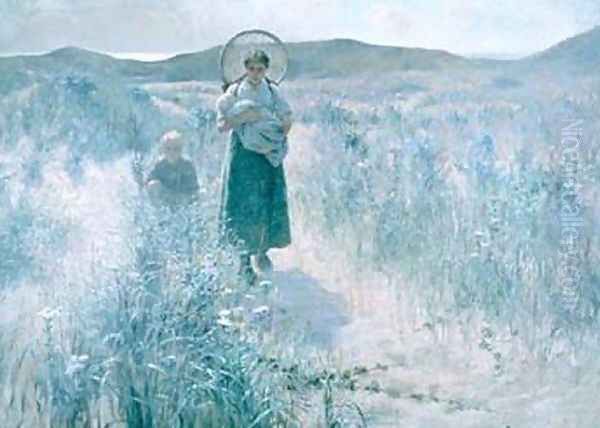
Tulip Culture (also known as La Culture des Tulipes or Tulip Growing) is perhaps his most quintessential Dutch landscape. Painted around 1889, this large canvas depicts vast, meticulously cultivated rows of brightly colored tulips stretching towards the horizon under a luminous sky. Figures of Dutch peasants can be seen working in the fields, integrated into the vibrant tapestry of color. This work epitomizes his fascination with the Dutch bulb industry and the stunning visual spectacle it created. It was widely exhibited and admired, further solidifying his reputation as a master of this genre.
Other notable works include Maternité (Maternity), which often depicted Dutch mothers with their children in sunlit, floral settings, emphasizing themes of tenderness and domestic harmony. The Flight into Egypt is another example of a religious subject transposed to a Dutch landscape, showcasing his distinctive approach to sacred art. His painting Vespers also gained considerable acclaim.
A Teacher and Mentor: The Egmond Summer School
Beyond his personal artistic output, George Hitchcock played an important role as an educator. He established a summer art school in Egmond, which attracted a diverse group of students eager to learn his techniques for capturing light and color. Among those who studied with him or were part of the Egmond circle were American artists such as Alice Blair Ring, Florence Wolf Gotthold, and potentially Letta Crapo Smith. British artist James Jebusa Shannon and Dutch painter Thamine Tadama-Groeneveld were also associated with the Egmond group.
Hitchcock's teaching emphasized plein air painting and the direct observation of nature. He encouraged his students to explore the unique visual qualities of the Dutch landscape and to develop their own responses to its beauty. His guidance helped to shape the careers of several artists and contributed to the dissemination of Impressionist-influenced techniques.
International Recognition and Expatriate Identity
George Hitchcock achieved considerable international recognition during his lifetime. He exhibited regularly at major venues in Europe and the United States, including the Paris Salon, the Royal Academy in London, and the National Academy of Design in New York. He received numerous awards and honors, including medals at the Paris Salon (1887), the Paris Exposition Universelle (1889), and the World's Columbian Exposition in Chicago (1893). He was made a Chevalier of the French Legion of Honor in 1894, an officer in 1905, and was also honored by Emperor Franz Joseph of Austria, becoming a Knight of the Order of Franz Joseph in 1890. He was an associate member of the National Academy of Design in New York from 1909.
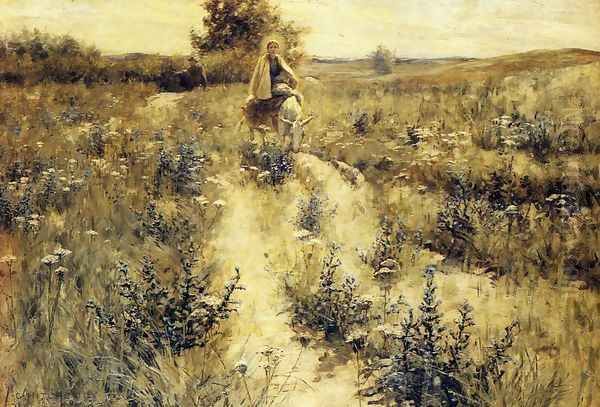
As an American expatriate artist, Hitchcock was part of a significant trend that included figures like John Singer Sargent, James McNeill Whistler, and Mary Cassatt. While Sargent and Whistler often focused on portraiture and cosmopolitan scenes, and Cassatt on intimate depictions of women and children in a French Impressionist style, Hitchcock distinguished himself by his deep immersion in the rural culture of a specific European region. His work offered American audiences a picturesque and often idealized vision of Holland, contributing to the romantic perception of the country.
His paintings were sought after by collectors on both sides of the Atlantic. His success demonstrated that American artists could achieve international standing while drawing inspiration from European sources, yet retaining a distinctive voice. He was also a writer, contributing articles on art to various publications, further sharing his insights and experiences.
Comparison with Contemporary Movements and Artists
Hitchcock's work can be situated within the broader context of late 19th-century art, which saw a shift away from strict academicism towards more personal and expressive styles. While clearly influenced by French Impressionism, particularly in his treatment of light and his preference for outdoor scenes, his style also shows affinities with other movements.
His detailed rendering of figures and his narrative clarity sometimes align more with Realism, though his idealized portrayal of peasant life distinguishes him from the grittier social realism of artists like Jean-François Millet. The Hague School, a Dutch movement of realist painters active from the 1860s to the 1890s, also focused on Dutch landscapes and peasant life. Artists like Jozef Israëls, Anton Mauve, and the Maris brothers (Jacob, Matthijs, and Willem) depicted similar subjects. However, the Hague School painters generally employed a more subdued, tonal palette, often emphasizing the atmospheric, sometimes melancholic, aspects of the Dutch landscape, in contrast to Hitchcock's brighter, sunnier depictions.
In his religious paintings, Hitchcock's approach can be seen as a form of Symbolism, where everyday scenes and figures are imbued with deeper spiritual meaning. His reinterpretation of biblical narratives in contemporary Dutch settings was a novel approach that resonated with a desire for more relatable and modern religious art, somewhat akin to the spirit of the Pre-Raphaelites in England who also sought to revitalize religious painting, though their styles differed.
Later Years and Enduring Legacy
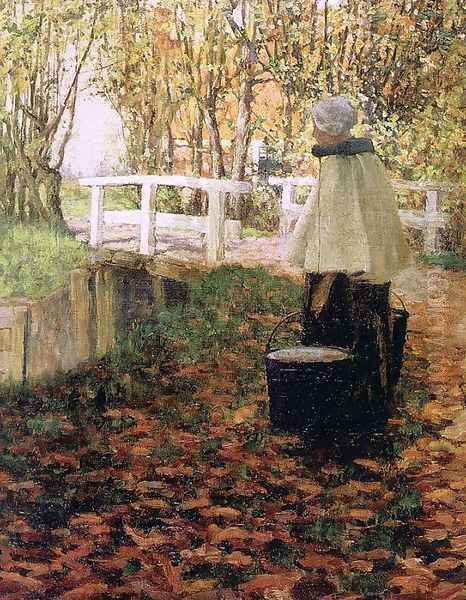
George Hitchcock continued to live and work primarily in Holland for the rest of his life, though he made trips back to the United States. In 1905, after the death of his first wife, Henrietta Richardson, he married British painter Cecil Jay, who was also working in Holland. He maintained his studio in Egmond aan den Hoef, which he named "Schuilenburg" (Shelter Castle), and it remained a hub of artistic activity.
He passed away on August 2, 1913, while on a houseboat in Marken, another picturesque Dutch location. His death marked the end of an era for the Egmond art colony, though its influence persisted.
George Hitchcock's legacy lies in his distinctive body of work that beautifully captured the light, color, and spirit of rural Holland. He was a pioneer among American artists in popularizing Dutch themes and demonstrating how Impressionist principles could be adapted to create a unique and appealing vision. His paintings remain celebrated for their technical skill, their radiant beauty, and their affectionate portrayal of a way of life that was already beginning to fade.
His works are held in the collections of numerous prestigious museums, including the Art Institute of Chicago (which holds his famed The Annunciation), the Musée d'Orsay in Paris, the Telfair Academy of Arts and Sciences in Savannah, Georgia, the Brooklyn Museum, and many others. Through these collections, George Hitchcock's sunlit visions of Holland continue to enchant viewers and secure his place as an important American artist of his generation. He successfully bridged American artistic ambition with European inspiration, leaving behind a luminous testament to the beauty he found in the Dutch landscape.